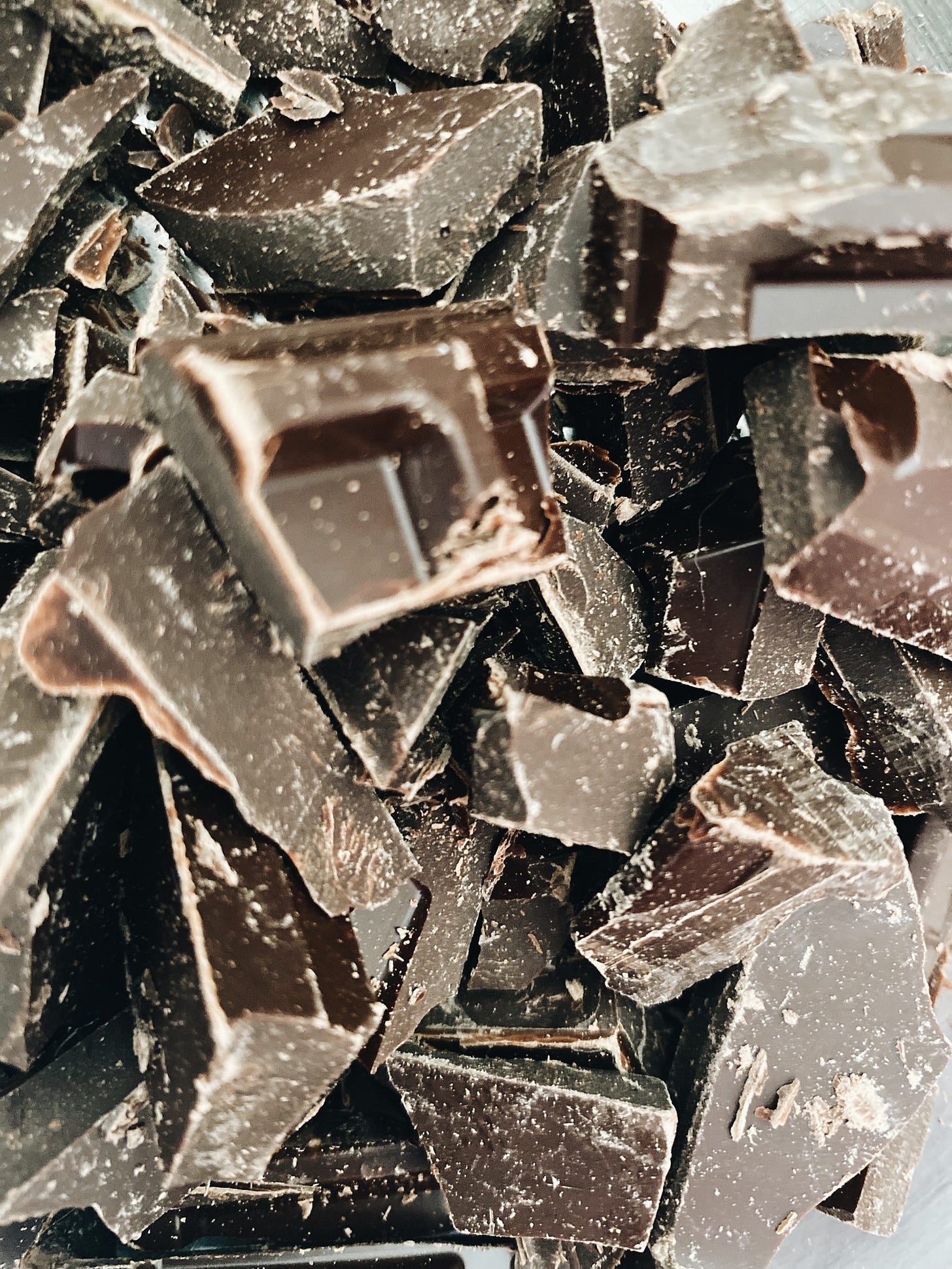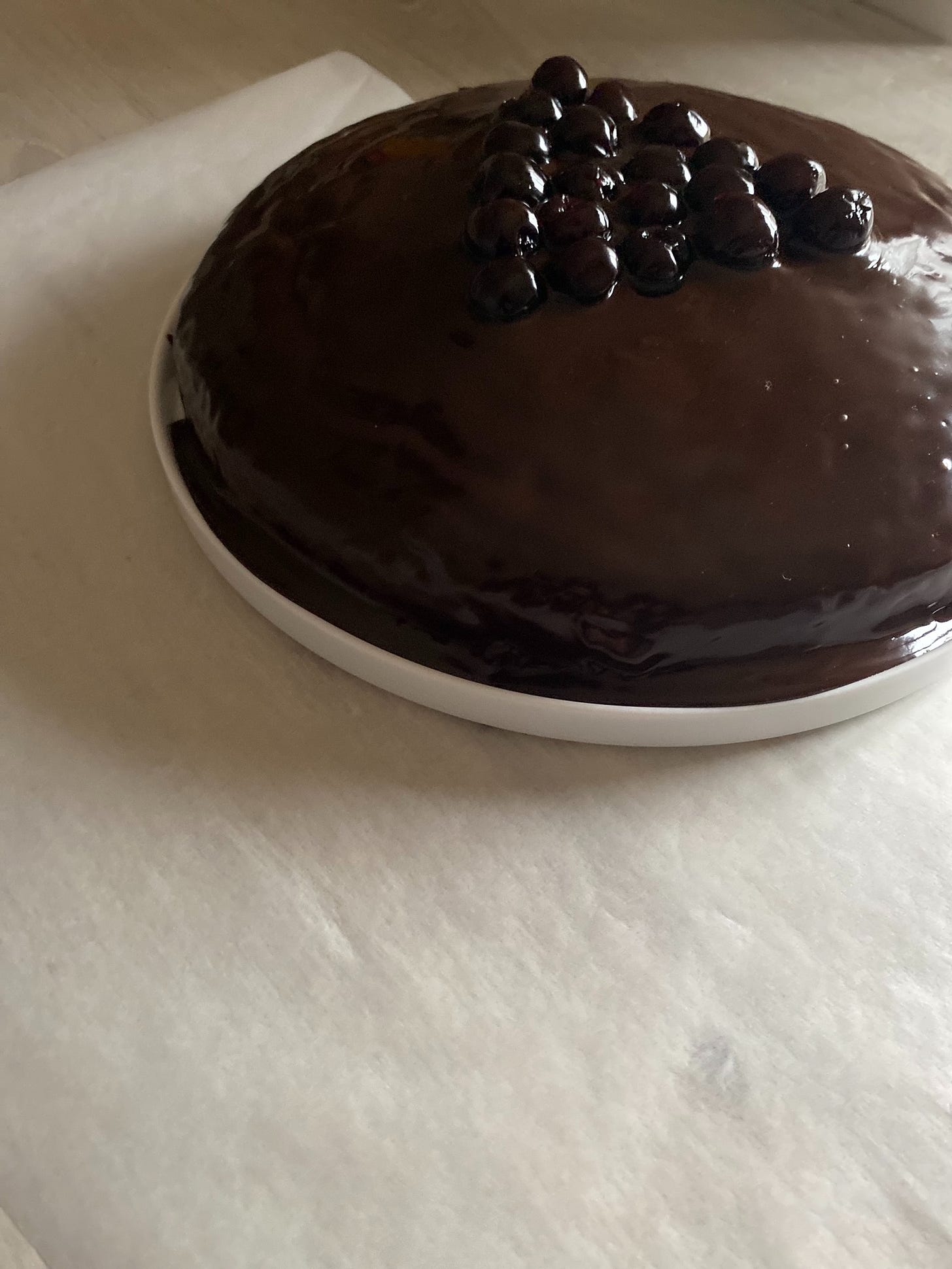One Bowl Dark Chocolate, Chestnut and Olive Oil Cake With Sour Black Cherries. (GF+DF).
Saints, Sinners and the Healing Indulgence of Love and Chocolate.
Google Maps, in the usual mad dash to get my son to practice, tells me at least several times a week that the city of Terni in Umbria, the birthplace of Saint Valentine, is only 28 minutes from our front door. I estimate that the closest part of the local border between Lazio and Umbria along the province of the same name lies just behind the Greccio Sanctuary. This hermitage carved into mountain rocks by Saint Francis of Assisi and his pals is visible from our front door here in Contigliano.
Why am I telling you this? Well, just to convey how much Umbrian culture is felt in Rieti and villages like ours dotted along these geopolitical designs.
The city of Rieti, at the geographical centre of Italy, is the capital of the modern Sabina region which lies between the Tiber River and the Sabine mountains. This region’s name is derived from the ancient Sabines an Italic tribe who descended from the Umbrians to occupy Appenine watersheds northeast of Rome. Their populations spanned from the outskirts of the city (the Sabina Romana) in the south to Terni and Norcia in the north and then east into areas that belonged to Abruzzo until recent times.
The province and capital of Rieti which still forms alta or northern Sabina was part of the province of Perugia and therefore part of Umbria until 1927 before it was annexed to Lazio together with the said areas of Abruzzo (which also includes Amatrice home of Lazio and Rome’s famous spaghetti all’amatriciana (gasp). Today the unique cultural and culinary influences of these surrounding territories are strongly felt, and this melting pot of la cucina povera makes cooking and eating here in Rieti both unique and interesting.
Our local culture here in Rieti, once a papal seat to a handful of popes, is what I like to call ‘saint forward’ meaning that the rhythms of local life are pretty much dictated by them. Although, I suppose this also applies to Italy as a whole.
Here the culture of Saint Francis is strongly felt as mentioned above as is the culture or ‘cult’ of San Valentino or Saint Valentine to name a few. These saints and their stories are part of the local fabric as well as a huge source of identity and pride.
Riccardo spent a good amount of time on the farm of his Nonni in a place called Montisola, a fraction of Contigliano which is 8 kilometres closer to the border. It is incredible how such a short distance can make such a huge difference in the cultural identity of a population. The inhabitants of Montisola and other bordering villages refer to the city of Terni rather than Rieti and I am sure there are examples of this all over Italy and the world.
Old habits die hard I suppose as Riccardo has always told stories about the salt-free bread or pane sciapo that would be delivered in filone or the big long loaves from Terni to assist Nonna Viola in providing food for an army. My late father-in-law would cross the river on a boat to attend school there, and when Riccardo was baptised in Siena, his late zio Antonio, also from Montisola, chose the name Valentino after this internationally renown but locally venerated saint. When many members of Riccardo’s extended family decided to spread their wings they made Terni their new home, not to mention Riccardo’s mother's ancestral ties with Perugia.
Black and white signage advises anyone driving into Terni that they are entering the birthplace of San Valentino, the saint of courtly love who we know as Saint Valentine. Every year the commercial Gods that be and both the religious and non-religious celebrate this symbolism with cards, roses and heart-shaped boxes of chocolate… and now that I think of it, Riccardo proposed to me (for the second time, don’t ask!) on Valentine’s Day in Lazio’s scenic Civita di Bagnoregio before we crossed the border into Umbria to have dinner in Orvieto.
So yes, when Valentine’s Day rolls around we have now been conditioned to seek out chocolate. And why is this? Honestly, I never even thought to ask myself this question before, but I found this article written by CNN that provides interesting historical detail.
What I do know, is that dark chocolate of 70% and above usually comes recommended as part of an anti-inflammatory diet for its high mineral and antioxidant content. It is always a welcome healthy indulgence where many including myself are concerned. Chocolate as pleasure and medicine has been used for thousands of years in Central and South America where the Aztec culture considered cocoa beans more valuable than gold. Then of course it was brought back from the New World like so many of the ingredients that would forever change the culinary face of Europe.
Umbria is the birthplace of Saint Valentine and funny enough it is also famously associated with chocolate. We are always delighted when Papa’ comes home with kisses in the form of Baci Perugina chocolates lined with fun love quotes. Perugia home of the Perugina Chocolate House is now known as the City of Chocolate. It also hosts the international exhibition ‘eurochocolate'. The Perugina name brought economic opportunity to Perugia but I am only learning that they are now owned by Nestle (see human rights violations), unfortunately!
This weekend in Terni, the image of ‘the city of lovers and sweetness is strengthened’ with the twenty-first edition of Cioccolentino’s BATTITI D'AMORE-themed chocolate fair.
Chocolate has long been framed as a product or ingredient that is indulgent and sinful but I am loving how this event seeks to reframe chocolate:
‘In fact, cocoa is one of the tastiest, but also most caloric, foods that can be found on our table. However, it is also fair to remember that cocoa and chocolate rich in cocoa (at least 70%) can be good for the heart and metabolism.’
Our own Rieti also hosts the National Chocolate Festival in October.
Speaking of reframing, I think it would be wonderful if we could look at doing this for Valentine’s Day as well. I remember how exciting it was as children when we bought fresh boxes of cards to address to our classmates’ which would then tear along perforated Valentine lines. We put ourselves out there and then asked ourselves ‘will I get chosen?’ and ‘will I receive cards in return’?
For children and lovers Valentine’s Day can be thrilling, but it can also be, as so many holidays are, quite painful for many. It is often a reminder of love lost, gone wrong or never found.
The Mediterranean Diet, the research around the Blue Zones and world religions remind us of the health benefits of love as a primary food (life’s food that is more important than what you put on your plate) which can be found in spirituality, family, friends and community. As the centre of everything, love is essential to our everyday well-being and longevity.
I get that Valentine’s Day is a culmination of history, tradition and folklore, but maybe we can start marking this as a day to celebrate universal love, the one that is ever present and available to everyone everywhere at all times. Maybe it can be about the empowerment of the love that you choose instead of being chosen. Maybe we can turn our backs on, if only for this day, the modern commercial non-inclusive images of red roses and racy lingerie.
Today many of us will be using food and its preparation as our love language. With Riccardo ‘out of village’ for work, I prepared this cake for my little loves to enjoy for their after-school merenda.
You will not find chocolate cake among the traditional recipes of la cucina sabina, but this cake is a little love letter to her territory. It is inspired by the amarene or black sour cherries that grow in the vast orchards of the Sabina bassa closer to Rome, the world-renowned olive oil that comes from the trees that carpet this land, the chestnuts that grow along the mountain passes that lead to Abruzzo and of course, this modern chocolate culture we find here in Rieti and the ancient parts of the Sabina to the north.
You will find this confection dark, decadent, and delicious but with the marrying of the unique medicinal properties of these ingredients, one might even dare to call it sinfully nutritious.
Dark Chocolate, Chestnut and Olive Oil Cake with Sour Black Cherries
Torta al cioccolato, castagne e olio d'oliva con le amarene
GF + DF
Ingredients:
For the cake:
125g gluten-free flour blend for baking
125g chestnut flour
50g dark cocoa powder + 1 tbsp more for the pan
150 grams of raw cane sugar
1 tsp baking soda
1 tsp baking powder
3 free-range eggs
200ml extra virgin olive oil + 1 tbsp more for the pan
120ml almond milk
60ml espresso
2 tsp of vanilla
Pinch of sea salt
For the topping:
1 100g jar of sour black cherries in syrup
Ganache:
150g dark cooking chocolate 50%+, roughly chopped
150g cream regular, plant-based or gluten-free
Method:
1. Lightly grease a standard springform pan with olive oil and lightly coat with sifted cocoa powder. Heat the oven to 180°C.
2. Sift the flour, cocoa powder, baking powder, baking soda and salt together in a big bowl. Make a well in the middle with your fingertips. Crack the eggs into the middle and whisk them together with the tip of a fork. Add the sugar and whisk it together with the egg. Then add the olive oil, almond milk, vanilla and espresso and gently blend the entire contents of the bowl with a wooden spoon until you have a smooth batter.
3. Pour the batter into your pan and bake for about 30 minutes. Remove from the oven and coat the top of the cake with 4-6 tablespoons of cherry syrup to absorb. Move the cake onto a serving dish or cake stand when cooled.
4. Add chocolate to a stainless steel or glass bowl. Bring the cream to a simmer in a saucepan (do not boil). Pour the cream over the chocolate and let it stand for 3-4 minutes before gently whisking them together to form the ganache.
5. Slowly pour the ganache over the cake in a thin stream. Let it cool for about 5 minutes and decorate the top of the cake with the cherries.
Notes:
Add a tablespoon or two of Kirsch to the syrup before spreading it over the top of the cake. You can chop up the cherries and add them directly to the cake batter if you wish. Top the cake with some powdered sugar for a simpler dressed-down version. Serve with vanilla ice cream, gelato alla panna, chantilly or mascarpone cream.









This sounds like heaven!